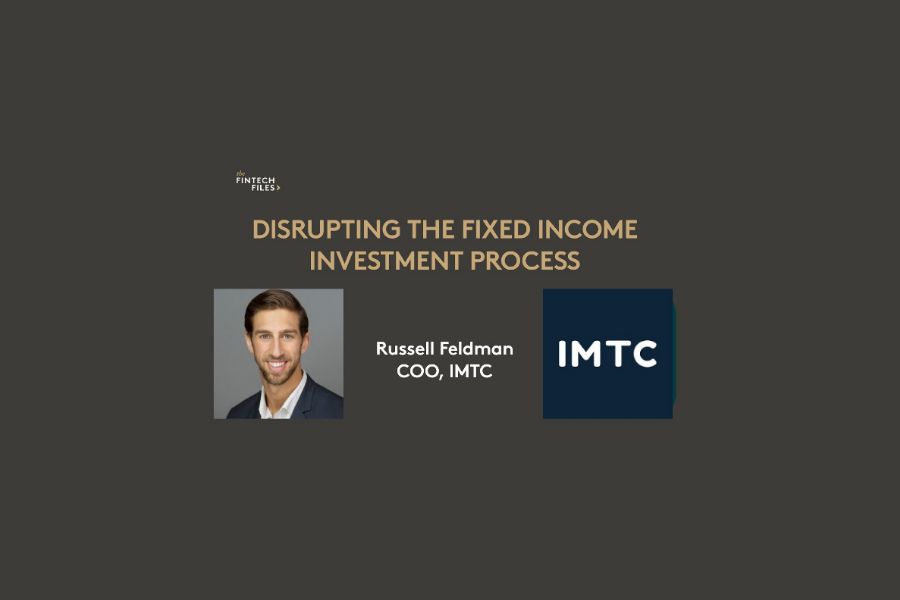IMTC CEO Russell Feldman on The Fintech Files Podcast

IMTC CEO Russell Feldman joined George Aliferis, host of The Fintech Files podcast, for a conversation about the fixed income market and how IMTC plays in as a cutting-edge, cloud-based investment management system in the space.
Listen to the podcast below or wherever you get your podcasts!
Podcast transcript
Introduction to The Fintech Files: Welcome to the podcast that unveils the future of investing. In each episode, we explore asset classes, trends and technologies with founders, investors and experts involved in shaping that future.
Today, your host George Aleeferis speaks to Russell Feldman, the CEO of IMTC, a cloud-based investment management system for fixed income investors.
George Aliferis: Russell, welcome to the show.
Russell Feldman: Thanks so much for having me. I’m honored to be here, George. I’m looking forward to our conversation.
GA:Could we first get a quick overview of the fixed income market?
RF: Absolutely. So, fixed income is the largest market out there right now; it’s $120 trillion in assets, and it’s made up of series of sub-markets, right? It’s not as simple and straightforward as the equities market. You know, within fixed income, you have asset types like, like munis, and corporates, and govies; and liquidity is different across each of them. And the tax benefits are unique and different across each. And, generally speaking, you know, fixed income has really lagged the equity markets from an innovation and from a technological stamp.
There’s 90 years in between kind of the launch of the first equity index and the first bond index. The first bond didn’t trade electronically until 30 years after the first equity traded. So I think from a holistic standpoint, it’s the biggest market, but you’re right. It doesn’t get enough love. And you know, it’s certainly ripe for disruption.
GA:Before we dive into it, could you tell us a bit about your background and how did you get to where you are now?
RF: Certainly. My history kind of starts back when I was a kid. I always wanted to be like, dad. Dad carried a briefcase, worked in finance. I thought that was super cool. I totally did not understand any of that until I graduated high school. And I wound up getting pretty sick. I spent a hundred plus days in the hospital. I had eight operations. It was a pretty intense year, but my father stayed with me every night while I was in the hospital. And we got to talking – there’s only so much sports you can talk about. So, we wound up talking about work a bit, and I began to understand what it meant. He ran a bond desk, and I learned about the fixed income markets, and what was really interesting was the inefficiencies and the lack of innovation in that market. And thought that, you know, how it worked was the market opened, you went to work, and then when the market closed, you came home, but it didn’t operate like that for him because of how inefficient things were.
And that really sparked my interest. I wound up ultimately going to school and working at a Deutsche and covering the largest clients of the bank from a fixed income standpoint. And I was the youngest guy in the desk. So, as always, you know, I got thrown into the technology piece and really got into the weeds and began to understand that the same inefficiencies he was seeing years before, I was seeing still. And so while for me, I wanted the efficiencies, you know, in the processes in place to be able to grab beers with my friends, and he wanted it to be able to spend time with his kid in the hospital. We had different reasons but both wanted the same efficiencies and not just from a process standpoint, but also from an outcome standpoint. And so that’s really what got me thinking and what got me involved in the fixed income technology space.
GA:That’s quite an origin story, and also the fact that you talked about inefficiencies back then, and this is very much relevant to speak about here, again.
Just to get an overview: we talk about fixed income and efficiency. Can you tell us, basically, who are the main players and give us a big picture of the market?
There’s a lot of different types of systems, but I think the big considerations are what are called legacy, you know, the legacy order management systems and the execution platforms. And I think, you know, those are the BlackRocks Aladdin (OMS), the Bloombergs. Charles River, Investortools Perform, and the legacy systems in the OMS space.
And then the advent of electronic trading has been a very big thing and a large reason for why the market is really ripe for disruption, which we’ll get into later, but that’s carried with MarketAxess and Tradeweb and several other execution platforms that have really come into the fray in the last several years.
GA: Just to make sure we bring everyone on board. I’ll share my perspective from a retail investor. So, I can trade whenever; I’ve got a broker, and I can trade equities. And there’s typically a bid offer spread on, I don’t know, very little, right? Something like zero-point-something percent. Whereas there’s tons of equities that are available across the world. Whereas iin the fixed income space where there’s not a lot of a lot of opportunities, but that’s for some retail, but also, if I trade the beat offer spread is, I don’t know, for many percentage points. So it feels completely different than the equity asset class. Is that something similar to what institutional will experience?
RF: Yeah, it’s an interesting part of the conversation, right? Because an individual investor, you wouldn’t ever really pull up, you know, an Alphabet bond on your phone and buy it. It’s too complex of a security in that there’s a lot of different facets to that, but I think, you know, some of what is particularly interesting – and I know you have a real interest in blockchain and crypto – is, you know, the considerations around standardizing the terms and conditions for bond offerings, right? If you didn’t have to look through 300 metrics and try and unique terms and conditions, you may actually be able to more readily open this market to the retail audience. But at current, absolutely. The bid-ask spread for a retail investor is going to be enormous. And, frankly speaking, given the illiquidity in the fixed income markets, or parts of the fixed income markets, the bid-ask spread, even for institutional investors, is going to be very substantial. So, there’s a lot to unpack there.
GA: Yeah, so that’s the nature of the market. I think it’s important to highlight that it’s maybe different from what we we know about trading as well.
So, you mentioned a lot of, what we call, legacy technology. What would be the typical experience?
RF: Before we get to that, let’s back up a little bit, because I think it’s important to note, you know, back in the day, people were actually doing bond math, you know, by hand you know, with a long, you know, pen and paper and, or pencil and paper. Trying to determine durations and whatnot. And so obviously that’s evolved into Excel spreadsheets back in the ’80s, which has evolved into, you know, portfolio and order management systems, which were largely evolved now – no fault of their own – but into, kind of, glorified Excel spreadsheets.
And so they are incredibly powerful, and they are very feature driven. So, somebody had a problem that was a feature that they needed, and they built it. That is one of the main issues, I think, that exists with the lack of innovation in this market is, you know, we didn’t take a holistic look at what the actual workflow is for a fixed income investor. And so a lot of these legacy systems are very analytical, you know, they have incredibly powerful calculation engines, but they don’t necessarily cater to the portfolio manager who’s sitting down to start their day to tackle X, Y, and Z. If you follow what I mean there.
GA: Sure. So what do you mean by a holistic? What could be the, let’s say, typical challenges?
RF: Yeah. So, a traditional investment manager’s workday would start showing up screening the markets for the bonds that are available and that makes sense for that particular portfolio. Then they’re going to pull up the portfolios that they have that are in need of attention, and they’re going to try to marry those bonds to those portfolios. And to do that, they’re going to have to validate all the analytics on the portfolios. They’re gonna have to validate the compliance, and the targets, and the rules associated with each of those portfolios.
If they can do all of that, and everything all checks out, great, then they move on and try to actually execute and buy that bond – if the bond is even still available; oftentimes it’s not available. If it is available, fantastic. Is it available at the same price? And do we like it at the price that it’s now available at? And does it still make sense for all of those portfolios that we just talked about? And if all of that is true, then great, we go ahead and execute it. And then we have to make sure that we update all of our information so that we don’t double spend any cash. As you can imagine, it’s a really linear problem. And at any point of failure, you’re jumping back all the way to the beginning of the equation. And I think that’s eally the problem with, or one of the main problems, with the workflow that exists in the market right now, and one that we’re certainly looking to change.
GA: Can you tell us a bit about how it looks from from the client perspective first in terms of IMTC? What do they see and what can they experience differently?
RF: There’s an analogy that I like to use that helps me explain to my mom what the heck it is that we do here that I can try to put into words here.
Basically, we’ll correlate IMTC to filling up your gas tank. So George, if you’re headed out to the beach for the weekend, and you pull up to a corner with three gas stations, you have one cheaper, one cleaner, and one faster, you know, you may think that’s an easy decision. There’s only three choices you can make: ”I’m going to grab the cheaper one because I’m a value investor,” and then you head down to the beach. No problem.
Now what happens if you have, if you pull up to that same corner and there are a thousand gas stations and the optimal output is actually the right combination of each of gas from each station gets you the most miles per gallon at the cheapest price? Trying to figure out what that combination would be is incredibly tedious, and you may say it’s not even worth my time, so I’m still just going to take the cheapest one and move on.
That’s a problem that exists in this market in a big way where investors are sometimes just saying, I don’t have the time to go through all these bonds, so I’ll just take $10 million and I’ll allocate it across these portfolios and that’ll be it. And if you magnify that problem on a larger scale, that’s where IMTC comes in. Because there are other solutions that can help you with the one car and many gas stations scenario, but where there is no other solution that does what we do is where you have a hundred cars and a thousand gas stations.
And you’re trying to find the optimal allocation for all of those gas stations, all those cars, simultaneously, while recognizing that each of those cars is unique. Some of them are electric vehicles. Some of them only take diesel. You know, some of them need a carwash, and simultaneously, there’s all these other people looking for gas and car washes.
And so trying to get to that optimal outcome is a really challenging problem that requires an optimization algorithm. And that’s really what IMTC brings to the table that doesn’t exist in the market right now. And in this case our cars Are bond portfolios and our stations are the bonds that are available in the market – there’s millions of them.
And so I think that’s, hopefully that helps paint a little bit of a picture of what we do. And I’m happy to talk more about that in the fixed income market.
GA: I understand. If we keep this car analogy, you provide decision making tools to pick the right gas station or the right bond.
Just to clarify even further – as a bond investor, there’ll be tons of bonds available that are very similar characteristics, but there are different instruments, right? So how do I pick the right one? And what are you building in order to help investors do that?
RF: Absolutely. And I’ll just say, not only are we helping to decide the right bond, but also maybe the wrong bonds, right?
What gas is in your tank already that we should siphon out in place of new gas that would be better, right? So it’s not just purchasing, it’s also what you need to sell. And the recommendations that we’re providing are bond-level recommendations. There’s not an allocation suggestion, Hey, you need 30% premium. And, you know, 20% premium plus. This is the exact, you know, gas station you need to go to, or the exact bond that you require in your portfolio.
And what we’ve done to deliver that to clients is a cloud-native investment management system. So it’s really what our teams are, our clients are booting up in the morning when they sit down at their desk, they’re pulling up IMTC. And they’re saying, you know, show me what portfolios require attention today, right? Where do I have over where by overdrawn cash? Or where are there violations within my portfolio? Or where has the market moves such that I’m now on the outside of the lines of my targets for these accounts? And how can I take action to rectify or to help me move more in line with my ideal?
GA: So it’s really, if I understand, it’s a holistic approach in terms of you take, let’s say, the data from the client as an input, as well as of the market of the fixed income market in general. And there’s a, would I say, a matching between the two?
RF: Let me build on that if I may.
We are actually taking data from a myriad of different sources. So for any given client, they may have a series of different custodians that they work with. We can connect to the individual custodians, or we connect to the aggregators that have all that data already. That feeds the system every day. So every day they come in, they get their fresh, clean data to look at and then intraday, when we’re building orders and having those orders, sent off, we’re taking information back to make sure that the portfolios are updated intraday. So the PMs can continue to work and operate at a high level with the appropriate data.
GA: Just to emphasize even more than that. So that means that the PM will come in in the morning. We’ll have, what is it? Highlighted instruments that they should pick? And also actions they should take. It’s the process that you were explaining earlier, but done for them?
RF: One of the major benefits of our platform is the flexibility that we provide because no two clients are exactly the same. People have different ways of trying to accomplish their goals because ultimately, largely, in the bond market, to invest enough cash for their clients.
Okay. We know that we needed to build a system that’s flexible enough to say, George shows up in the morning and he wants to see a dashboard that shows him the top five things. But Russell shows up in the morning, and he wants to see a dashboard that shows these five things. Or Russell needs a hyperlink that shows up every day that he can click on that updates automatically that pulls in all the portfolios that have more than 5% cash, and have violations in them, and that are in the investment grade strategy. I need this information for my strategy; That’s the only information I want to see. So I have a smart link that takes me directly to that every morning and that list of portfolios. And from there, what’s unique is every action begets another action. So when you’re looking at that screen, the system is asking you, do you want to create a sandbox environment where we can help you mock up trades to better accomplish the goals for these portfolios? And each step builds on itself, and that really what I think part of the power of our system is.
GA: And to keep the focus on the client again here, how is that transition possible from the previous way of doing things, which was maybe not in a spreadsheet, but as you mentioned improved spreadsheet-like system to I need to create a platform, cloud-based etc. How do you go from A to Z?
RF: There’s a lot of things that have to happen, but I’ll just to go back for a second, just to clarify, I think 50% of our clients are using spreadsheets, custodians, and an execution platform, right? 50% of our clients have an existing system, and they’re still using spreadsheets because it’s difficult for people to get away from Excel because of the lack of the workload driven nature of the system that exists in the market right now. The way you go from A to Z is, you know, there, there are certain things that I’ve had to happen, and there are certain trends that have happened in the marketplace that have really helped accelerate that move from on-premises legacy tech to cloud-native solutions that really solve major workflow problems. Happy to dive into some of those tailwinds, if that would be helpful.
GA: So definitely the moving to the cloud – it’s a big driver of innovation, and that’s, I guess, what you’re pushing and,
RF: And I would just say, there are major benefits that cloud technologies can experience, especially in the fixed income space where there’s so much data. There’s so much information. The scalability of the cloud is a huge benefit, a huge positive.
And then really the elasticity of the cloud for us makes a big difference, right? If we have, you know, a hundred users on at 7:00 AM, we’ve got several service terminal spun up. If we then go to a thousand users at 9:00 AM, we just scale up additional servers. So there are no additional latency for our users. And then at 9:00 PM, when we have 15 users on, we’re scaling back down.
So there’s a there’s major cost-benefits to the user, to the actual end client. And ultimately we’re able to operate much more efficiently from a development standpoint, and that’s actually allowing us to operate one version of our system and not 500 versions where you have to do maintenance and you have to spend developer time and energy on upkeep for those other systems. And so for, you know, cloud providers that are engaging with really this one platform that has unique components to it and feature flags and whatnot. But that really, I think there’s a lot of benefit to be had from cloud. There’s just a few examples.
GA: Is it still something that they need to consider and assess, etc., or are they bought into the idea and then it’s about implementation? Can you give us like a state of industry?
RF: Three or four years ago, those were a lot of the questions we were getting. We were certainly ahead of the curve from a cloud standpoint. We are really the only cloud-native system in our space, and we got a lot of questions about cloud. We leaned heavily on the JEDI project that the Department of Defense moved a lot of their their files to the cloud. And that obviously certainly helped to build credibility, but ultimately I think COVID provided the kick that a lot of folks needed to really recognize the importance of cloud and the ability to operate in a decentralized capacity where you don’t necessarily need to be sitting next to somebody on the trading desk in order to accomplish whatever goal you have in that moment. You can’t always stand up and shout across the desk to find out what the risk limit is. You need to be able to be operating on systems that are, in real time, providing you the information you need in order to be successful,
GA: Can I go a little bit as well behind the seat in terms of what did you have to build in order to achieve that and to offer those kinds of capabilities to your clients?
RF: This has been a journey for us. We build everything on Microsoft Azure, and while the system from a front-end standpoint looks quite nice because we’ve had the benefit of being built, you know, just a few years ago. The backend is really where most of the innovation has happened for us.
Our developers have done an amazing job organizing the data in certain ways that allow us to deliver results instantaneously to our clients. And that’s really where the magic happened. Again, we talked a little bit about the optimization algorithm and what goes into that, and a lot of that is all about, is really backend, of course.
And so much of what we do is in the backend focused, but, you know, DevOps principles have been crucial to us from an innovation standpoint and from our ability to build and deliver technology quickly to our clients. A lot of the players in our space need to wait for large-scale quarterly releases or semi-annual releases. And we’re releasing, you know, to our production environment. And that can be small bug fixes. That can be larger enhancements, obviously with communication to clients, but all of that is possible because of the processes that have been put in place really from the beginning and the framework that was laid out that’s really helped us largely be successful.
GA: We’ve had a very simplified view of fixed income, which is like buying bonds and that’s it. But the reality is more complex. What are the trends that you see in the market?
Let’s start talking about the markets just for a moment. Today is going to be an interesting day. I would expect the Fed to move rates 50 basis points. That’s already priced into the market and there’s, you know, it’s been an interesting time as rates have been rising, I think what you’re seeing now is people having the decision to make: whether they’re willing to take on the reinvestment risk of rates rising, or they want to stay on the sidelines and wait as rates continue to rise. But they know that when they top out, everybody’s going to pile in and obviously, you know, it’s not always easy to know when that’s going to happen. And so I think there is, you know, there’s a bit of turbulence in the markets. The 10yr has doubled year to date and that’s certainly crazy. And you know, it makes for interesting and interesting time, and it also means that optimizing your outcomes is even more important. And you know, I think the trend in the market is certainly a good one and one that backs up the need for innovation in this space.
Because again, as I said earlier, there’s too much going on in fixed income. It’s not as simple as in equities. There’s too many data points. There’s too much information, too many bonds. And we’re talking about you know, 50,000 U.S. issuers alone to 5,000 in the equity space, we’re talking about over a million bonds in the U.S. alone, well over a million. And so I think that the scale of data and information is such that, you know, it requires technology to to move all participants forward.
GA: It’s a good follow-up to a discussion I had a couple of years ago with the CEO of Taboola, which is a fixed income pension provider. And we went through all those different aspects. So now we’re talking about the market that’s Fed-driven, but there’s all different types of risks. And then there’s all different types of data. If you manage to take care of that, then you can deal with the important things. However, if you don’t have a platform to optimize this, then you’re stuck with this rather than making the strategic decision you to make. That’s a good summary.
RF: Absolutely. I think when you think about what nobody knew about the invasion of Ukraine, that was obviously unforeseen, right? And that certainly caused major pressure on oil and gas prices. And so knowing what the optimal output is at any given moment is really crucial. It’s not enough to say, oh, I rebalanced these portfolios last week. That’s all good. We need to be able to react in real time to deliver real value to our end client.
And the trends from that standpoint are that clients are looking for more customization, right? The end user wants to be catered to in a much more sophisticated way. We want to know that what we’re investing in is clean energy. We want to know that we’re not investing in, you know, companies that are funding terrorism. We want to know the unique components of our portfolios. And so even, you know, even smaller retail investors are demanding that of their advisors and of their wealth managers.
And so know, I think the trend there is to be able to provide customization, and that comes back to being able to provide a cloud-based solution that is scalable. It comes back to being able to organize the data efficiently and effectively. If you’re a portfolio manager and you have, you know, several hundred accounts, you get to spend, you know, about 36 seconds a day on any given account. And obviously, that’s not going to be a productive pitch to an end client, 36 seconds is what I can provide for you on any given day. And you know, I look forward to doing business with you. That’s not the right way to pitch yourself. And so I think, you know, those managers need to know that they need technology that allows them to scale their operations, but in a really customized way,
GA: There’s probably a lot to say, but I really want to move on and look a bit more at the future and your outlook on the industry and what are you most excited about?
RF: I think actually I could build on what I was just talking about. I think one of the things that really nobody is doing in our space and fixed income space is something called custom indexing. And it’s popular in the equities market. And it’s the ability to say, I like the S&P 500, but I want clean energy companies. Yeah. Extra Tesla. And I only want, Coca-Cola not Pepsi. And you know, you can turn the knobs and snap your fingers and you can have that basket presented to you. That hasn’t to this point been possible in fixed income, certainly because of liquidity reasons, but also because of a lack of technology that can do that. What I’m really excited about is the ability for us to deliver on that, that custom index. It’s something that we’ve been working on. It’s something that the Optimizer enables us to do to essentially take an index and deliver a client a basket of securities that matches the characteristics of that index with very detailed and unique customization associated. And these are suggestions that are live and available in the market today. And I think that’s crucial as well. This is not placeholders. And it’s not about filling gaps about delivering value. That’s what I’m super excited about.
GA: One question that I find is almost compulsory at this stage in 2022 is do you see the blockchain having any meaningful impact
RF: Yeah, I think it’s really interesting. We actually started a company a couple of years ago called Bond.one. We were trying to tokenize debt securities in the marketplace. And I think we were a little too early. There was a, you know, not enough regulatory direction and it didn’t make sense at the time, but there are still folks who are looking to do things like that. And I think smart contracts can play a huge role in, you know, in the fixed income world. As I said, I think I mentioned earlier in the conversation given the number of terms and conditions and the uniqueness of each bond contract, having some level of standardization and having a smart contract that unlocks those unique characteristics, I think is a really a really big opportunity, frankly, for this market. And I, I definitely see it coming into play, you know, in time. It definitely requires more regulatory direction and more information. But I think we’re definitely headed in that direction.
GA: We were talking about the Russian bonds and how little the notes at the bottom of the contract were significantly where suddenly becoming increasingly, dramatically important. That’s the nature of the fixed income world. That’s what we’re dealing with.
RF: Exactly. And that’s part of what we were talking about earlier. Having individual investors, buying individual bonds is can be a crapshoot for them because they didn’t catch the clawback provision. And that really changes the entirety of that, you know, about security.
GA: I can definitely see that, customization and smart contracts. So that’s a very exciting development as we’re coming towards the end of this podcast.
I’d like to ask a couple of personal questions. So you were born into the fixed income space, and that was quite an origin story, but I still have to ask, what would you do if you were to choose a different carrier path?
RF: Yeah, I think. I’m a little stuck in the startup space at the moment, and if I were thinking about specifically in the startup world, I probably would want to go work on the software development side of things. I give my developers quite a hard time. And so it’s probably only right for me to put myself in their shoes for a bit; what they do is amazing. And I’m super interested in coding and developing. And so I think that would certainly be an interesting path.
And if we’re stepping outside of the world of finance and software, I always had this weird, a dream of coaching, you know, basketball, whether that’s at the collegiate level or the high school level. So if I was really doing something completely different, that’s probably where I would be.
GA: That’s very interesting. Again, we have a lot of people with alternative paths about sports in this podcast.
Final question. How do you invest personally? Big picture.
RF: Not well enough, I would say. I can use some help, so if you have any suggestions, let me know.
I think I try to be as diversified as I can be. I have a long time horizon, so I’m certainly largely invested in the equities market, you know, through funds. I am trying to keep it pretty mainstream there. I allocate a portion of my own investing to crypto, to DeFi. you know, not enough to make me rich and not enough to make me poor.
It’s been really helpful for me to learn and to understand that market. And I’ve been really interested in it. And then the last bit of it is I used to invest in venture firms and startups as well. So I’m always looking for good ideas.
GA: Yes. Very interesting to see how you have a diversified portfolio. I’m very interested in the DeFi space myself, and I like to say I try to make it as little exciting as possible because there’s plenty of excitement. So my approach is to try to get it steady and boring income rather than the excitement we can find.
RF: The yield farming and the, you know, 60,000% APY plays are certainly alluring on the the surface, but I know from experience that they don’t all pan out exactly the way that you’d hoped.
It’s good to be balanced and certainly to, you know, to have an allocation that is to fixed income, because I think that certainly needs to be part of any well-diversified and balanced portfolio.
GA: Wonderful. Russell, thank you so much. It’s been really great speaking to you and talking about this fixed income asset class, which we know it’s not much-loved, but it’s the biggest, and it’s an absolutely critical part of our portfolios. So despite what we see on the surface, it’s very important to learn from it and to learn what’s available now for investors. So thanks for fixing a little bit for that.
RF: Absolutely. Thanks.
.





